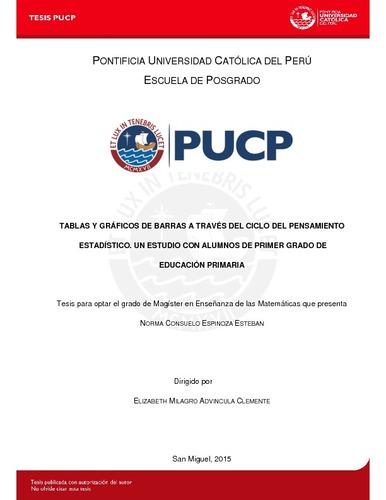| dc.contributor.advisor | Advíncula Clemente, Elizabeth Milagro | |
| dc.contributor.author | Espinoza Esteban, Norma Consuelo | es_ES |
| dc.date.accessioned | 2016-04-21T13:42:01Z | es_ES |
| dc.date.available | 2016-04-21T13:42:01Z | es_ES |
| dc.date.created | 2015 | es_ES |
| dc.date.issued | 2016-04-21 | es_ES |
| dc.identifier.uri | http://hdl.handle.net/20.500.12404/6759 | |
| dc.description.abstract | El presente trabajo de investigación tiene por objetivo analizar cómo estudiantes de 6 a 7 años de
edad, que se encuentran en primer grado de Educación Primaria, transitan por el ciclo de
investigación del pensamiento estadístico cuando trabajan con tablas y gráficos de barras. Para lo
cual utilizamos una actividad que diseñamos según las fases de ciclo de investigación: Problema,
Plan, Datos, Análisis y Conclusiones (PPDAC). Así nos planteamos la siguiente pregunta de
investigación: ¿Cómo los estudiantes de primer grado de educación primaria transitan por el ciclo
del pensamiento estadístico cuando desarrollan actividades relacionadas con tablas y gráficos de
barras? En nuestro trabajo tomamos como marco referencial la propuesta de Wild y Pfannkuch,
sobre el desarrollo del pensamiento estadístico pues consideramos que es un proceso que puede
ser incorporado desde los primeros grados de la educación básica. También consideramos los
niveles de lectura propuestos por Curcio para identificar la lectura que realizan los estudiantes
sobre información presentada en tablas o gráficos de barras. Usamos una metodología de
investigación cualitativa como es el Estudio de Caso pues nos interesa reconocer y describir la
manera en que los estudiantes transitan por las fases del ciclo investigativo cuando trabajan con
tablas y gráficos de barras. A modo de conclusión podemos mencionar que el desarrollo de la
actividad permitió que los estudiantes de primer grado de educación primaria transiten por el
ciclo investigativo y lean información directa que se presenta en tablas y gráficos de barras,
logrando de esta manera el primer nivel de lectura de Curcio. | es_ES |
| dc.description.abstract | This research aims to analyze how students 6-7 years of age, who are in first grade of primary
school, passing through the research cycle of statistical thinking when working with tables and
bar graphs. To use an activity which we designed according to the phases of the research cycle:
Problem, Plan, Data Analysis and Conclusions (PPDAC). So we have the following research
question: How do students first grade of primary education transiting cycle thinking when
developing statistical tables and graphs related to bar activities? In our work we take as a
reference the proposed Wild and Pfannkuch, on the development of statistical thinking because
we believe that is a process that can be built from the earliest grades of basic education. Also we
consider reading levels proposed by Curcio to identify the reading done by students on
information presented in tables or bar charts. We used a qualitative research methodology such as
case study because we want to recognize and describe how students pass through the phases of
the research cycle when working with tables and bar charts. In conclusion we mention that the
development of the activity allowed students to first grade of primary education transiting the
research cycle and read direct information presented in tables and bar graphs, thus achieving the
first level of reading Curcio. | es_ES |
| dc.language.iso | spa | es_ES |
| dc.publisher | Pontificia Universidad Católica del Perú | es_ES |
| dc.rights | info:eu-repo/semantics/openAccess | es_ES |
| dc.rights.uri | http://creativecommons.org/licenses/by-nc-nd/2.5/pe/ | * |
| dc.subject | Matemáticas--Estudio y enseñanza (Primaria). | es_ES |
| dc.subject | Estadística--Tablas. | es_ES |
| dc.subject | Educación primaria--Investigaciones. | es_ES |
| dc.title | Tablas y gráficos de barras a través del ciclo del pensamiento estadístico : un estudio con alumnos de primer grado de educación primaria | es_ES |
| dc.type | info:eu-repo/semantics/masterThesis | es_ES |
| thesis.degree.name | Maestro en la enseñanza de las Matemáticas | es_ES |
| thesis.degree.level | Maestría | es_ES |
| thesis.degree.grantor | Pontificia Universidad Católica del Perú. Escuela de Posgrado | es_ES |
| thesis.degree.discipline | Enseñanza de las Matemáticas | es_ES |
| renati.discipline | 199117 | es_ES |
| renati.level | https://purl.org/pe-repo/renati/level#maestro | es_ES |
| renati.type | http://purl.org/pe-repo/renati/type#tesis | es_ES |
| dc.publisher.country | PE | es_ES |
| dc.subject.ocde | https://purl.org/pe-repo/ocde/ford#5.03.01 | es_ES |






